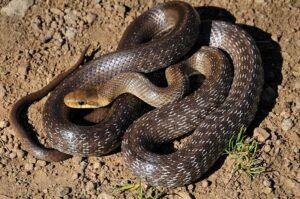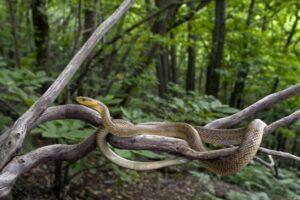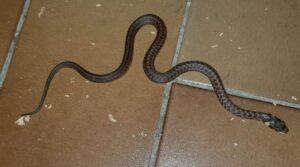The long, dark, and slender Aesculapian snake is an excellent climber and can climb up vertical tree trunks with no branches. The common name of this colubrid is derived from Asclepius, the Greek God of healing. It is because it often hid in temples dedicated to Him. In fact, the common symbol of medicine and pharmacology today bears the image of the Aesculapian snake coiled around a rod.
Scientific Classifications
- Suborder:Serpentes
- Family:Colubridae
- Genus:Zamenis
- Species:Z. longissimus
Conservation Status
Description
Size
The adults are usually 43.3-63 inches (110-160 cm) in size. But they can grow to 79 inches (200 cm), with the record length being 89 inches (225 cm). Its body weight ranges from 350 g to 890 g.
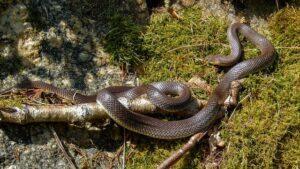
Color and Appearance
The snake is covered with smooth scales lending a metallic sheen to its body. Its color is uniformly bronzy and can be brownish-green, olive-yellow, and almost black at times. Often, it has a regular pattern of white-edged dorsal scales appearing as white freckles all over the body or moiré-like structures at places. It enhances the metallic shine of the snake. Pale-colored individuals may have 2 darker longitudinal lines along the flanks. The belly color varies from plain yellow to off-white, and the round iris is amber to ochre. There are melanistic, albinotic, erythristic, and dark grey natural forms of the colubrid.
Sexual dimorphism is present with the males being bigger than the females having longer tails and wider tail bases.
The juveniles have yellow collars on their necks that fade with age. They are brownish-green or light green with various darker patterns on their back and flanks. Two darker patches of lines run along the sides. There are also several prominent dark spots on their heads. They reach sexual maturity at 4-6 years.
Are They Dangerous to Humans
The secretive snake can be tame when in contact with humans. But their cryptic coloring makes it easier for them to escape and hide in their natural environment. If cornered, they may stand their ground and try to intimidate their attacker by exhibiting a chewing movement of their mouth and occasional bites that are non-venomous.
Aesculapian Snakes at a Glance
Distribution
It can be found in the UK (North Wales, Colwyn Bay, and Regents Park, London), most of France excepting the northern part, the eastern side of the northern Spanish coast and the Spanish Pyrenees, Italy (excepting Sicily and the southern part), the Balkan peninsula and parts of Austria and Switzerland. Some isolated populations exist northwest of the Czech Republic and in western Germany.
Habitat
It is commonly found in forested, warm, moderately humid, hilly, or rocky areas with proper sun exposure and varied vegetation.
The diurnal snake comes out in the early morning and late afternoon in the warmer months. Above 81°F (27°C), it avoids direct sun exposure and shows no activity at much higher temperatures. It shows some activity level even during hibernation to maintain a body temperature of 41°F (5°C) and occasionally emerges to bask on sunny days.
The main threat to their population is habitat destruction and killing by humans. New construction of roads and increasing traffic leave them at risk of population fragmentation and loss of genetic exchange.
Lifespan
The Aesculapian snake has an estimated lifespan of 25-30 years.
Predators
Foxes, wild boars, birds of prey, hedgehogs, badgers, and other mustelids eat them. The juveniles are consumed by smooth snakes and other reptile-eating snakes.
Diet
The colubrid mainly preys on rodents up to the size of rats and other small mammals like moles and shrews. It also eats birds as well as their eggs and nestlings. The juveniles eat arthropods and lizards.
Though it mainly suffocates its prey by constriction, smaller food items may be gulped alive without constriction or simply crushed by its jaws.
Reproduction
Oviparous (lays eggs that hatch outside the body)
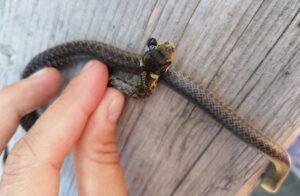
Breeding happens annually after hibernation in spring, usually from mid-May to mid-June. Rival males engage in a ritual fight to court a female. The courtship takes the form of a beautiful dance between a pair with the front portion of their bodies raised in an S-shape and tails entwined. The male may also grasp the opposite sex’s head with his jaw.
4-6 weeks later, about 10 eggs are laid in a warm, moist spot where organic decomposition takes place (under hay piles, in rotting wood piles, heaps of manure or leaf mold, old tree stumps, etc.). The eggs incubate for around 6-10 weeks before hatching.
Source
balcanica.info, pixabay.com, wildlifeinfrance.com, scontent.fccu4-2.fna.fbcdn.net, ardeaprints.com

